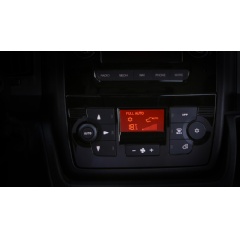The Importance of a Climate Control System in a Camper
Nowadays a climate control system is no longer an optional or a luxury; it has become a common feature across all the main types of vehicle, installed on more than 80% of those on the road. It functions both as an air-conditioner and as a heater, because it regulates the ambient conditions inside the vehicle by controlling the amount, temperature and humidity of the air supplied.
The climate control system operates as a closed loop, working on the principle of the pressure difference and changes of state in the coolant gas as it travels through the circuit. It is a self-contained system, with its own motor (the compressor), heat exchangers (condenser and evaporator), filters and pipes, which is always pressurised, even when not in use.
This is one of the reasons why to keep a climate control system in the best working order it must be used often, in both summer and winter. At all times of year, the system helps to provide safer driving conditions.
The larger windows and long journey times typical of campers are features which make a climate control system more and more important for on-board comfort. In winter, it assists with demisting by controlling the humidity level in the cab, thus helping to improve visibility and driving safety. In summer, it makes driving easier and less tiring, in spite of the blazing sun. What’s more, the interior filters also improve the quality of the air supplied. Before entering the interior by means of the aeration ducts, the air passes through special filters which trap its pollutant particles and unpleasant odours. On board Fiat Ducato Camper, the climate control system offers high-powered ventilation throughout the cab, with manual or automatic control, the option of an additional heater and prefittings for climate control of the rear of the vehicle.
Remember that for optimal comfort and to avoid thermal shocks, especially in summer, the climate control system temperature should never be set too low: the ideal difference between outdoor and interior temperatures should never be more than 6° – 7°. Also, the cool air flow should always be directed upward and never directly at the body. This allows effective mixing of the (heavier) cold air with the (lighter) warm air.
At the end of a long trip, especially on damp, rainy days, it is best to ventilate all the aeration ducts thoroughly before stopping. Just switch off the climate control system and leave the ventilation running. This will enable the evaporator and ducts to dry out and you will acclimatise to the outdoor temperature. It also limits the formation of mould and bacteria due to damp, which may cause unpleasant odours and allergic reactions. Naturally, regular replacement of the interior filter is essential to ensure clean air on board at all times.
Also remember that in order to operate at peak efficiency, the climate control system should be charged with coolant gas every two years.
( Press Release Image: https://photos.webwire.com/prmedia/7/220326/220326-1.jpg )
WebWireID220326
This news content was configured by WebWire editorial staff. Linking is permitted.
News Release Distribution and Press Release Distribution Services Provided by WebWire.
